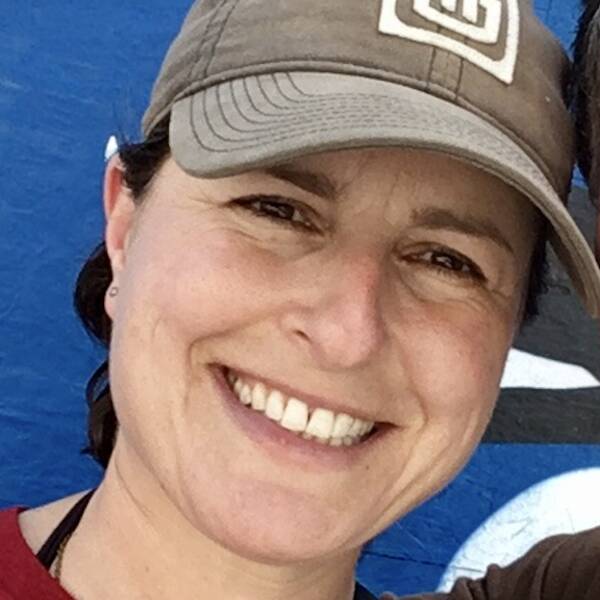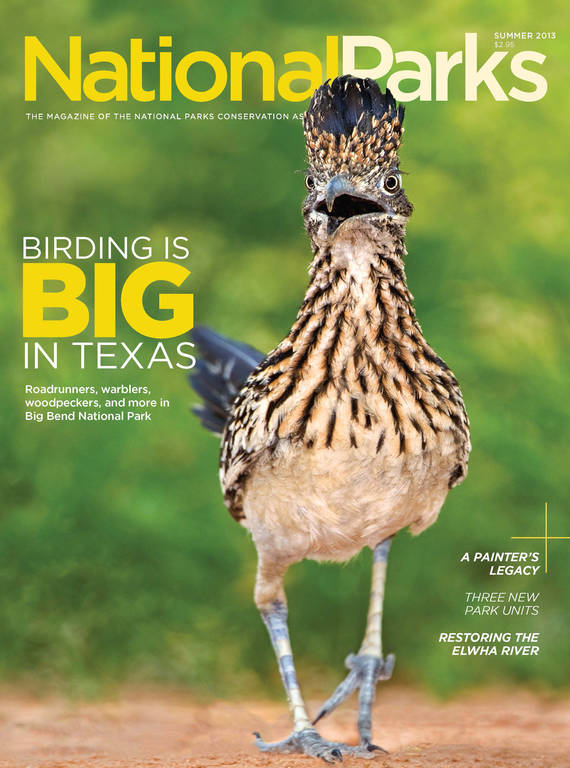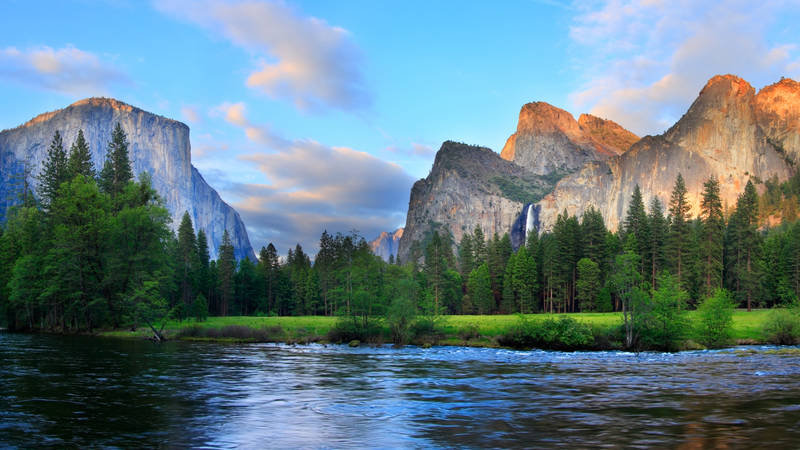Summer 2013
A Bird’s Eye View
There’s no place like Big Bend National Park to slow down, grab a pair of binoculars, and reconnect with your inner birder.
I had barely introduced myself to Mark Flippo when he began peppering me with questions: Do you own your own binoculars? Do you like birds? Do you look for them at home? Do you feed them? Do you keep a list?
I was exploring Big Bend National Park in West Texas, and I had arranged a private tour with the man who knows birds better than anyone else in these parts. Flippo retired in 2011 after 17 years working as a park ranger at Big Bend, and he now guides private birding tours; he’s fond of saying that the best bird is whatever bird is in front of you at that moment. Before I’d left home on the East Coast, my neighbor had loaned me her bird field guide and binoculars, and she had gone green with envy when I mentioned my destination. In just a few days at the park, I had not only mastered putting the correct end of the binoculars to my eyes, but I had seen dozens of species and even recognized a few on my own. Yet I still had much to learn. So I figured, what better way to spend the morning than with the alpha birder?
But as I stood at Cottonwood Campground, answering each of Flippo’s questions with a nod or shake, I didn’t feel like much of a bird-watcher. Instead, I had a funny sense that Flippo was observing me. He explained that the string of questions helps him gauge the experience level of his students before a tour. I nodded again, squinting into the morning sun. A few feet in front of me, in a worn fleece jacket and baseball cap, Flippo set up binoculars on a tripod. Then he looked up, paused for a moment, and identified his first creature.
“You,” he said, looking me in the eye. “You’re a fledgling.”
The Best Pit Stop
TRAVEL ESSENTIALS
Big Bend, the size of Rhode Island, is the mecca of rare things, from cacti to scorpions to night skies darker than anywhere else in the Lower 48. But it’s especially known for its birds. Located in the most remote part of the state, the park sits on the migration path connecting South America, Central America, and North America. So it’s a prime spot for bird-watching, especially in the spring. Nearly 450 species of birds have been documented here, and the park even plays host to birds that fly over occasionally from Mexico for a visit, called “rarities” or “accidentals”—news of which will make birders do wacky things like drive nonstop from Florida just to snap a picture.
If you’re a migrating bird, Big Bend is the best pit stop ever. It offers such diversity in climate, plant and animal life, geography, and elevation (1,800 to 7,800 feet) that no matter what a bird fancies, she is likely to find it here. So with little more than an appreciation for backyard chirps under my belt, I took on Big Bend in January, determined to try my hand at “bird” as a verb.
Birding Year-Round
The park’s chief of interpretation, David Elkowitz, met me at the Panther Junction Visitor Center and asked me about my bird sightings thus far.
“Let’s see,” I said, visualizing my drive into the park, where I passed a cactus the color of blueberry yogurt. “Small and brown, medium and gray, and large and black.” I was hoping he’d be impressed with my observation skills. He wasn’t. But like any good birder, he was patient.
Big Bend was named for the sharp turn in the Rio Grande that forms the park’s southern border. Elkowitz suggested we drive down to Rio Grande Village, one of the park’s best birding spots along the river. As we descended, he pointed out changes in the landscape, and the Sierra Del Carmen Mountains in Mexico.
“There’s a roadrunner,” he said. I was jotting something in my notebook, and by the time I looked up, it was gone.
“Are they like the cartoons?” I asked.
“They are,” he said. “They do cartoonish things. They run on roads, they’re very fast, and they’re incredible predators. If they were six feet tall, I’m convinced we’d be extinct.”
We drove through a quiet camping area spotted with cottonwood trees. As we crossed a little boardwalk, a great blue heron stood across the pond, preening. Elkowitz identified the trill of a kingfisher and the clown-like sound of a pied-billed grebe. Mid-sentence, he’d interrupt himself, looking skyward, with, “There goes somebody,” or, “Whoops, there’s a black vulture.”
The one bird that sets everyone aflutter is the Colima warbler. The only way to see it in the United States is by visiting Big Bend’s Chisos Mountains between April and September, and many birders travel epic distances to do exactly that. I was just happy to be handling the binoculars adeptly enough to see a ladder-backed woodpecker, with his bright red head and zebra-like back. He was hanging upside down in a tree, pecking furiously, trying to remove bark and find insects.
And there were nearly two dozen other species, like the brilliant red vermillion flycatcher, the yellow-rumped warbler, the golden-fronted woodpecker, and the yellow-headed verdin. “We’re getting a goodly number of birds for wintertime,” Elkowitz said, as we folded up our binoculars. We drove back into the mountains, and at one point he slammed on the brakes and backed up to see a bird darting around in the shrubs. “I’m driving in reverse,” he said, still fixated on the side of the road, “like a tourist.”
Bare-Naked Birding
SIDE TRIP
Over lunch, I flipped through the park’s visitors’ guide and stopped at an article explaining how “bare-naked birding” could be “quite a liberating experience!” The idea was that leaving behind all the potentially restrictive gear—binoculars, telephoto lenses, apps, field guides—allows you to concentrate on using your eyes and ears. After all, paying attention to a bird’s size, shape, behavior, colors, and movement is good practice for a beginner. I was sold.
The next couple days, I explored the park in the nude, so to speak, with only my senses to guide me. I tackled two hikes near the Chisos Mountains Lodge, where I was staying. Window View Trail just before sunset offered a spectacular view of the desert floor through a narrow gap in the basin’s wall. Lost Mine Trail began with signs explaining what to do if I encountered a black bear or mountain lion. I stopped several times along the way. Without the crunching of each footstep, all was quiet, and it was only then that I could hear the faint sound of a bird bopping around in the brush, looking for food. When the occasional insect buzzed in front of my face, I no longer thought of it as pesky; now, I saw it as bird breakfast. I reached the top—6,900 feet—and spun around, taking in the rock formations and peaks. And I had it all to myself. On the entire trail, I still had yet to run into any other hikers.
I also took a road trip, which is kind of what you do each time you get in your car in this giant playground. I headed west, driving several hours along Ross Maxwell Scenic Drive, stopping every few miles to enjoy overlooks and short hikes. And further proof that birds were everywhere: I turned on the radio, expecting only static, and was surprised to tune in to Marfa Public Radio to hear a nature program about none other than the vermilion flycatcher.
Driving the winding roads back to the lodge, I proudly identified a couple of roadrunners. And then, before I realized what I was doing, I found myself stopping and shifting into reverse to watch one of them. And I couldn’t help laughing—partly at the funny bird, and partly at the funny birder I had become.
Winged Things and Hot Springs
One morning I drove down to Daniels Ranch, near Rio Grande Village, for a guided group bird walk with a ranger who introduced herself as Cookie. She talked about the different bird habitats, trees, and seasons. (“It’s hotter than beans here in the summer.”) We walked down to the river, and Cookie pointed out raccoon tracks and some birds catching insects. She identified an Inca dove, but I missed it; a New Yorker in the group pulled up a picture on his iPad.
After Cookie’s tour, I drove the short distance back to the boardwalk, passing a little coyote on the way. One of the lures of this park is that solitude is easy to find. I sat on a warm bench in the sun to enjoy a book—William Least Heat-Moon’s Blue Highways—but I had barely finished one paragraph before I realized I wasn’t alone. Something rustled and gurgled behind me. I whipped my head around and saw what was probably a grebe swimming across the pond, making a “V” in the still water. A second one swam not far behind. Another bird bounced from reed to reed. And soon, I gave up on reading.
A few miles north, I drove down a long dirt road to reach the hot springs, where I ran into a San Antonio couple I’d met on the bird walk. We rolled up our pants and soaked our feet in the 105º F water, on the banks of the Rio Grande. When we needed to cool off, we waded in the river—still low after recent droughts. The other side of the river was so close, yet for many years there was no legal way to get there from the park. Before 9/11, Big Bend visitors and Mexicans used to cross the river with ease—and no documentation—between Rio Grande Village and the town of Boquillas. On April 10, 2013, after more than a decade with no access (resulting in economic devastation for the town), authorities opened a formal border crossing. Now, visitors with passports can take a little boat to the other side for souvenirs, taquitos, and cervezas.
The Best Bird

National Parks
You can read this and other stories about history, nature, culture, art, conservation, travel, science and more in National Parks magazine. Your tax-deductible membership donation of $25 or more entitles…
See more ›As I sat near the southwest border of the park, with my teacher, Mark Flippo, in my final day at the park, I did everything I could to identify the “best bird” right in front of me.
“How big is he?” he asked. “What’s he look like?”
“He’s got a skinny beak, so he’s probably an insect-eater,” I said.
“Good. What’s he doing?”
I described the bird—sitting on a post, looking for bugs—eventually figuring out he was in the flycatcher family. It turned out to be an Eastern phoebe.
“Some people will see a color, start flipping through their book, and miss all the things the bird is doing,” Flippo said. “You need patience. If birding does anything for you, it makes you slow down.”
To me, it was like a game, and we played over and over. The ping-pong-ball-sized bird with a hypodermic needle of a beak was the ruby-crowned kinglet. The scaly birds moving their heads up and down like sewing machines, pecking the ground, were Inca doves. We’d follow birds in flight and watch them land on mesquite trees, and we’d look at colors, compare them to pictures in the field guide, and narrow down possibilities. Each bird became a problem to solve, and I was having more fun watching them than I ever could have imagined. And hence, time flew. Soon, I was saying goodbye to Flippo at his pickup, and he reminded me that I could bird anywhere. “If you don’t have the time to go birding,” he counseled, “there’s something wrong with your life.” Then he told me my fledgling days were over. “I release you,” he said, turning to his truck with a wave of his arm. “Go bird.”
About the author
-
 Melanie D.G. Kaplan Author
Melanie D.G. Kaplan AuthorMelanie D.G. Kaplan is a Washington, D.C.-based writer. Her book, "LAB DOG: A Beagle and His Human Investigate the Surprising World of Animal Research," will be published by Hachette in 2025.



